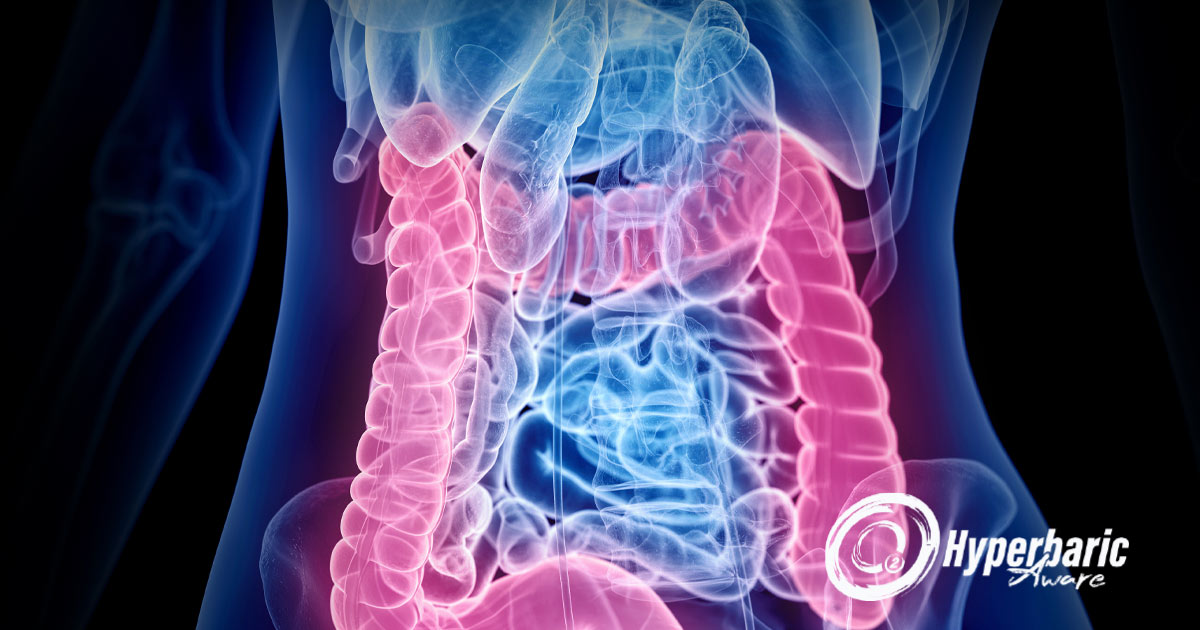Hyperbaric oxygen therapy for inflammatory bowel disease
Enoch Huang, MD, MPH&TH, FACEP, FACCWS

Hyperbaric Oxygen (HBO2)
HBO2 has been used to treat a variety of different diseases that all have hypoxia – a lack of oxygen – as a common denominator. HBO2 has been shown to stimulate new blood growth and enhance the body’s ability to kill bacteria by increasing the amount of oxygen in the body ten-fold or more. In addition to providing more oxygen, HBO2 has been shown to have anti-inflammatory effects, which has led researchers to investigate new diseases that may benefit from this treatment.
Inflammatory Bowel Disease (IBD)
IBD is a general description of diseases that involve chronic inflammation of the intestinal tract. Ulcerative colitis (UC) and Crohn’s disease (CD) are two specific diseases that fit under the umbrella of IBD. In addition to inflammation of the intestines, patients with UC may have ulcers (sores) of the superficial lining of the colon, while patients with CD may have ulcers that affect deeper layers of the intestines. Both UC and CD share common symptoms of abdominal pain, diarrhea, rectal bleeding, fatigue, loss of appetite, and weight loss. These symptoms may be mild to severe, and they are characterized by periods of intense flareup in-between periods that are free of symptoms.
Ulcerative Colitis
UC can be classified depending on the extent and severity of the disease. The anatomic extent of disease can be limited to the rectum (ulcerative proctitis), distal to the splenic flexure (left sided/distal colitis), or proximal to the splenic flexure (pancolitis). Severity can range from clinical remission to severe.1 The disease is lifelong, and 90% of patients will have a relapsing and remitting course of symptoms.2 In a 2019 study of 717 UC patients 5 years after their diagnosis, 6% of patients underwent a colectomy (removal of the colon) and 23% were hospitalized. In patients with more limited distal disease, 21% progressed to pancolitis while 27% of patients with initial pancolitis had an improvement in the extent of their disease.3 First line treatment of mild flares of UC include steroids with successful remission in 11% to 80% of cases.2
For patients with moderate to severe flares that do not respond to first-line treatments, hospital admission is usually required for immunomodulator treatments, intravenous steroids, and cyclosporin to produce remission. Failure to respond to these treatments often leads to colectomy and the formation of an ileal pouch-anal anastomosis. While removal of the colon usually cures UC, up to 50% of patients will have at least 1 episode of pouchitis.4 This can be associated with increased stool frequency, urgency, incontinence, and nocturnal seepage. While pouchitis is initially treated with antibiotics, chronic antibiotic-resistant pouchitis (CARP) is seen in 5-19% of cases and requires second-line therapy with immunotherapy.5 Failure to respond to second-line therapy may lead to pouch failure and the need for a permanent ileostomy.
Crohn’s Disease
While UC is restricted to a single, superficial layer of the colon, CD can occur in any part of the intestinal tract from the mouth to the colon and can affect multiple areas simultaneously. It is usually found in the small and large intestine, however, and involves deeper layers of the intestine. Many of the symptoms of UC are also experienced by patients with CD, but the more penetrating nature of CD can lead to draining tunnels (fistulas) that form from the colon to other soft structures like the skin, vagina, or bladder. Peri-anal fistulas are commonly reported, with 1/3 of patients developing at least one fistula during their disease course.6 Medical treatment of these fistulas with immunotherapy is successful about 40% of the time.7,8 Placement of bands (setons) in these fistulas can prevent fluid collections and abscess formation, but some patients require surgery with a success rate of about 60%.9,10 Fistulas are reported to recur in about half of patients within the next 2 years.9,10
The case for HBO2
There are three main targets within the IBD spectrum where HBO2 has been investigated: reduction in severity of acute moderate-severe flares of IBD, chronic pouchitis following colectomy, and peri-anal fistula from CD.
Management of IBD Flares
A 2012 review looked at the use of HBO2 for refractive IBD that had failed to respond to medical management. Symptoms improved in all (39/39) patients with UC and in 78% (31/40) of patients with CD.11 A 2014 review of 613 patients with IBD receiving HBO2 showed that the clinical response rate for UC was 88% (288/327), and the clinical response rate for UC was 85% (243/286). Overall improvement in IBD symptoms was 86%.12
A randomized, double-blind, multicenter study of 18 patients who were suffering moderate-severe flares of UC that required hospital admission revealed that half of the patients receiving HBO2 had clinical remission at study day 5 and 10 when compared to the sham group, where no patients were in clinical remission. Furthermore, only 10% of patients in the HBO2 group required second-line therapy during hospitalization as opposed to 63% of patients in the sham group. In-hospital colectomy was not required for any of the HBO2 group, while 38% of patients in the sham group required colectomy.13 A second multicenter study comparing a course of 3 vs. 5 HBO2 sessions for moderate-severe UC flares found that 55% (11/20) responded by day 3 and only 3 patients progressed to needing second-line interventions. Patients who received 5 days of HBO2 had better relief of symptoms than those who only received 3 days of HBO2. None of the 20 patients who received HBO2 required immunotherapy or colectomy.14
Chronic Antibiotic Resistant Pouchitis
A single-center retrospective review of 46 patients with CARP treated with HBO2 between January 2015 and October 2019 used a modified Pouch Disease Activity Index (mPDAI) to measure clinical response to HBO2. Patients had a significantly lower symptoms score following HBO2, and endoscopy showed improvement in the afferent limb of the pouch (11/13, 84.6%), main body (29/35, 82.9%), and cuff (20/27, 74.1%), with 13/46 (31.8%) experiencing complete endoscopic remission in all 3 pouch segments.15
Peri-anal fistula from Crohn’s Disease
The HOT-TOPIC study compared 20 CD patients with high perianal fistula(s) who had failed 6 months of conventional treatment to 8 patients who declined HBO2. At week 16, 13/20 (65%) of HBO2 patients had no symptoms. No patients in the HBO2 group required surgery, and all setons were able to be removed. In the control group of 8 patients, however, 3 patients required ligation of the intersphincteric fistula tract at 16 weeks, one patient had a fistulotomy, and the remaining four had setons left in place. In the four patients who had surgery, only two patients were without symptoms. The remaining four non-surgical control patients continued to have symptoms.16
Summary
In summary, there is growing evidence that HBO2 reduces the severity and length of moderate-severe IBD flares that require hospitalization, reduces the number of patients that require colectomy, and improves the quality of life for these patients. It reduces the severity of pouchitis symptoms and increases resolution of disease. For CD patients with perianal fistulas that have been refractive to standard treatment, HBO2 has been as successful at healing these fistulas as surgical approaches have been. While these are promising results, this is based on studies with small sample sizes, and further research must be done to prove the benefits of HBO2. Despite that caveat, the patients described in the studies above have failed to respond to medical management, and a trial of HBO2 may be their only option to prevent permanent surgical interventions.

Enoch Huang, MD, MPH&TM, FACEP, FUHM, FACCWS
Medical Director
Hyperbaric Medicine and Chronic Wound Care
Legacy Emanuel Medical Center in Portland, OR.
References
- serological classification of inflammatory bowel disease: report of a Working Party of the 2005 Montreal World Congress of Gastroenterology. Can J Gastroenterol. 2005;19 Suppl A:5A-36A.
- Langholz E, Munkholm P, Davidsen M, Binder V. Course of ulcerative colitis: analysis of changes in disease activity over years. Gastroenterology. 1994;107(1):3-11.
- Burisch J, Katsanos KH, Christodoulou DK, et al. Natural Disease Course of Ulcerative Colitis During the First Five Years of Follow-up in a European Population-based Inception Cohort-An Epi-IBD Study. J Crohns Colitis. 2019;13(2):198-208.
- Fazio VW, Ziv Y, Church JM, et al. Ileal pouch-anal anastomoses complications and function in 1005 patients. Ann Surg. 1995;222(2):120-127.
- Tulchinsky H, Hawley PR, Nicholls J. Long-term failure after restorative proctocolectomy for ulcerative colitis. Ann Surg. 2003;238(2):229-234.
- Schwartz DA, Loftus EV, Jr., Tremaine WJ, et al. The natural history of fistulizing Crohn’s disease in Olmsted County, Minnesota. Gastroenterology. 2002;122(4):875-880.
- Sands BE, Anderson FH, Bernstein CN, et al. Infliximab maintenance therapy for fistulizing Crohn’s disease. N Engl J Med. 2004;350(9):876-885.
- Colombel JF, Sandborn WJ, Rutgeerts P, et al. Adalimumab for maintenance of clinical response and remission in patients with Crohn’s disease: the CHARM trial. Gastroenterology. 2007;132(1):52-65.
- Gingold DS, Murrell ZA, Fleshner PR. A prospective evaluation of the ligation of the intersphincteric tract procedure for complex anal fistula in patients with Crohn’s disease. Ann Surg. 2014;260(6):1057-1061.
- van der Hagen SJ, Baeten CG, Soeters PB, van Gemert WG. Long-term outcome following mucosal advancement flap for high perianal fistulas and fistulotomy for low perianal fistulas: recurrent perianal fistulas: failure of treatment or recurrent patient disease? Int J Colorectal Dis. 2006;21(8):784-790.
- Rossignol DA. Hyperbaric oxygen treatment for inflammatory bowel disease: a systematic review and analysis. Med Gas Res. 2012;2(1):6.
- Dulai PS, Gleeson MW, Taylor D, Holubar SD, Buckey JC, Siegel CA. Systematic review: The safety and efficacy of hyperbaric oxygen therapy for inflammatory bowel disease. Aliment Pharmacol Ther. 2014;39(11):1266-1275.
- Dulai PS, Buckey JC, Jr., Raffals LE, et al. Hyperbaric oxygen therapy is well tolerated and effective for ulcerative colitis patients hospitalized for moderate-severe flares: a phase 2A pilot multi-center, randomized, double-blind, sham-controlled trial. Am J Gastroenterol. 2018;113(10):1516-1523.
- Dulai PS, Raffals LE, Hudesman D, et al. A phase 2B randomised trial of hyperbaric oxygen therapy for ulcerative colitis patients hospitalised for moderate to severe flares. Aliment Pharmacol Ther. 2020;52(6):955-963.
- Hasan B, Yim Y, Ur Rashid M, et al. Hyperbaric Oxygen Therapy in Chronic Inflammatory Conditions of the Pouch. Inflamm Bowel Dis. 2020.
- Lansdorp CA, Gecse KB, Buskens CJ, et al. Hyperbaric oxygen therapy for the treatment of perianal fistulas in 20 patients with Crohn’s disease. Aliment Pharmacol Ther. 2021;53(5):587-597.
Categories
Contributing Specialists

